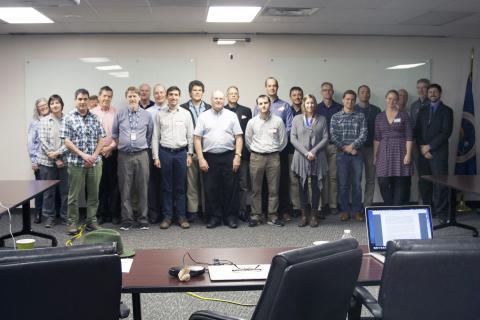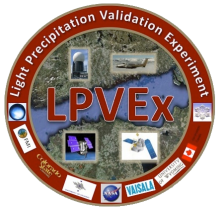 The Global Hydrology Resource Center (GHRC) hosted its annual User Working Group meeting on October 22-23, 2019. This meeting is designed to bring experts from the various fields supported by the GHRC to Huntsville. These fields include lightning, severe weather, the Global Precipitation Measuring mission, hurricane sciences, and applications. During the meeting, GHRC provides our responses to the user working group from the previous year, highlights activities since the previous meeting, and states planned activities for the year ahead. The process is interactive as the user working group discusses GHRC’s activities, provides recommendations for the year ahead, as well as provides strategic guidance as to how GHRC should best position itself for the future. This year, the primary focus for GHRC was discussing its role in transitioning to being a cloud-native Distributed Active Archive Center. This included our efforts for the past year to bring our data holdings to the cloud, a demonstration of the field campaign explorer, as well as discussions with the user working group on their recommendations for continued cloud work that can enhance and improve the user experience.
The Global Hydrology Resource Center (GHRC) hosted its annual User Working Group meeting on October 22-23, 2019. This meeting is designed to bring experts from the various fields supported by the GHRC to Huntsville. These fields include lightning, severe weather, the Global Precipitation Measuring mission, hurricane sciences, and applications. During the meeting, GHRC provides our responses to the user working group from the previous year, highlights activities since the previous meeting, and states planned activities for the year ahead. The process is interactive as the user working group discusses GHRC’s activities, provides recommendations for the year ahead, as well as provides strategic guidance as to how GHRC should best position itself for the future. This year, the primary focus for GHRC was discussing its role in transitioning to being a cloud-native Distributed Active Archive Center. This included our efforts for the past year to bring our data holdings to the cloud, a demonstration of the field campaign explorer, as well as discussions with the user working group on their recommendations for continued cloud work that can enhance and improve the user experience.


 The NASA Global Hydrology Resource Center (GHRC) Distributed Active Archive Center (DAAC) published the GPM Ground Validation Physicum Building Mast Meteorological Data LPVEx dataset. This dataset consists of meteorological data (temperature, pressure, wind, precipitation, and radiation) collected from the Station for Measuring Ecosystem-Atmosphere Relations III (SMEAR III) at the University of Helsinki’s Physicum building rooftop weather station in Helsinki, Finland. These data were collected during the Global Precipitation Measurement (GPM) mission Light Precipitation Validation Experiment (LPVEx) field campaign that took place around the Gulf of Finland, aiming to provide additional high-latitude, light rainfall measurements for the improvement of GPM satellite precipitation algorithms. These meteorological data files are available from September 16 through October 22, 2010 in ASCII-CSV and ASCII text formats. It should be noted that these dataset files are not available for each day of the campaign period. Missing dates include 09/23/10 - 10/10/10, 10/13/10, and 10/15/10 - 10/18/10. There are also no .CSV files for 09/22/10 and 10/22/10 and no .txt file for 09/19/10.
The NASA Global Hydrology Resource Center (GHRC) Distributed Active Archive Center (DAAC) published the GPM Ground Validation Physicum Building Mast Meteorological Data LPVEx dataset. This dataset consists of meteorological data (temperature, pressure, wind, precipitation, and radiation) collected from the Station for Measuring Ecosystem-Atmosphere Relations III (SMEAR III) at the University of Helsinki’s Physicum building rooftop weather station in Helsinki, Finland. These data were collected during the Global Precipitation Measurement (GPM) mission Light Precipitation Validation Experiment (LPVEx) field campaign that took place around the Gulf of Finland, aiming to provide additional high-latitude, light rainfall measurements for the improvement of GPM satellite precipitation algorithms. These meteorological data files are available from September 16 through October 22, 2010 in ASCII-CSV and ASCII text formats. It should be noted that these dataset files are not available for each day of the campaign period. Missing dates include 09/23/10 - 10/10/10, 10/13/10, and 10/15/10 - 10/18/10. There are also no .CSV files for 09/22/10 and 10/22/10 and no .txt file for 09/19/10. The NASA Global Hydrology Resource Center (GHRC) Distributed Active Archive Center (DAAC) published the GPM Ground Validation Dual-frequency Dual-polarized Doppler Radar (D3R) ICE POP dataset. This dataset includes reflectivity, differential reflectivity, copolar correlation coefficient, differential propagation phase, radial velocity, and spectrum width data collected by the Dual-frequency Dual-polarized Doppler Radar (D3R) during the International Collaborative Experiments for Pyeongchang 2018 Olympic and Paralympic Winter Games (ICE-POP) field campaign in South Korea. The two major objectives of ICE-POP were to study severe winter weather events in regions of complex terrain and improve the short-term forecasting of such events. These data contributed to Global Precipitation Measurement mission Ground Validation (GPM GV) campaign efforts to improve satellite estimates of orographic winter precipitation. The D3R was developed by a government-industry-academic consortium with funding from NASA's GPM Project. It operates at the ku (13.91 GHz ± 25 MHz) and ka (35.56 GHz ± 25 MHz) frequencies covering a fixed range from 450 m to 39.75 km. The D3R dataset files are available from November 1, 2017 through March 17, 2018 in netCDF-4 format. It should be noted that there are several dates during ICE-POP when D3R data are not available due to maintenance or clear weather.
The NASA Global Hydrology Resource Center (GHRC) Distributed Active Archive Center (DAAC) published the GPM Ground Validation Dual-frequency Dual-polarized Doppler Radar (D3R) ICE POP dataset. This dataset includes reflectivity, differential reflectivity, copolar correlation coefficient, differential propagation phase, radial velocity, and spectrum width data collected by the Dual-frequency Dual-polarized Doppler Radar (D3R) during the International Collaborative Experiments for Pyeongchang 2018 Olympic and Paralympic Winter Games (ICE-POP) field campaign in South Korea. The two major objectives of ICE-POP were to study severe winter weather events in regions of complex terrain and improve the short-term forecasting of such events. These data contributed to Global Precipitation Measurement mission Ground Validation (GPM GV) campaign efforts to improve satellite estimates of orographic winter precipitation. The D3R was developed by a government-industry-academic consortium with funding from NASA's GPM Project. It operates at the ku (13.91 GHz ± 25 MHz) and ka (35.56 GHz ± 25 MHz) frequencies covering a fixed range from 450 m to 39.75 km. The D3R dataset files are available from November 1, 2017 through March 17, 2018 in netCDF-4 format. It should be noted that there are several dates during ICE-POP when D3R data are not available due to maintenance or clear weather. 



